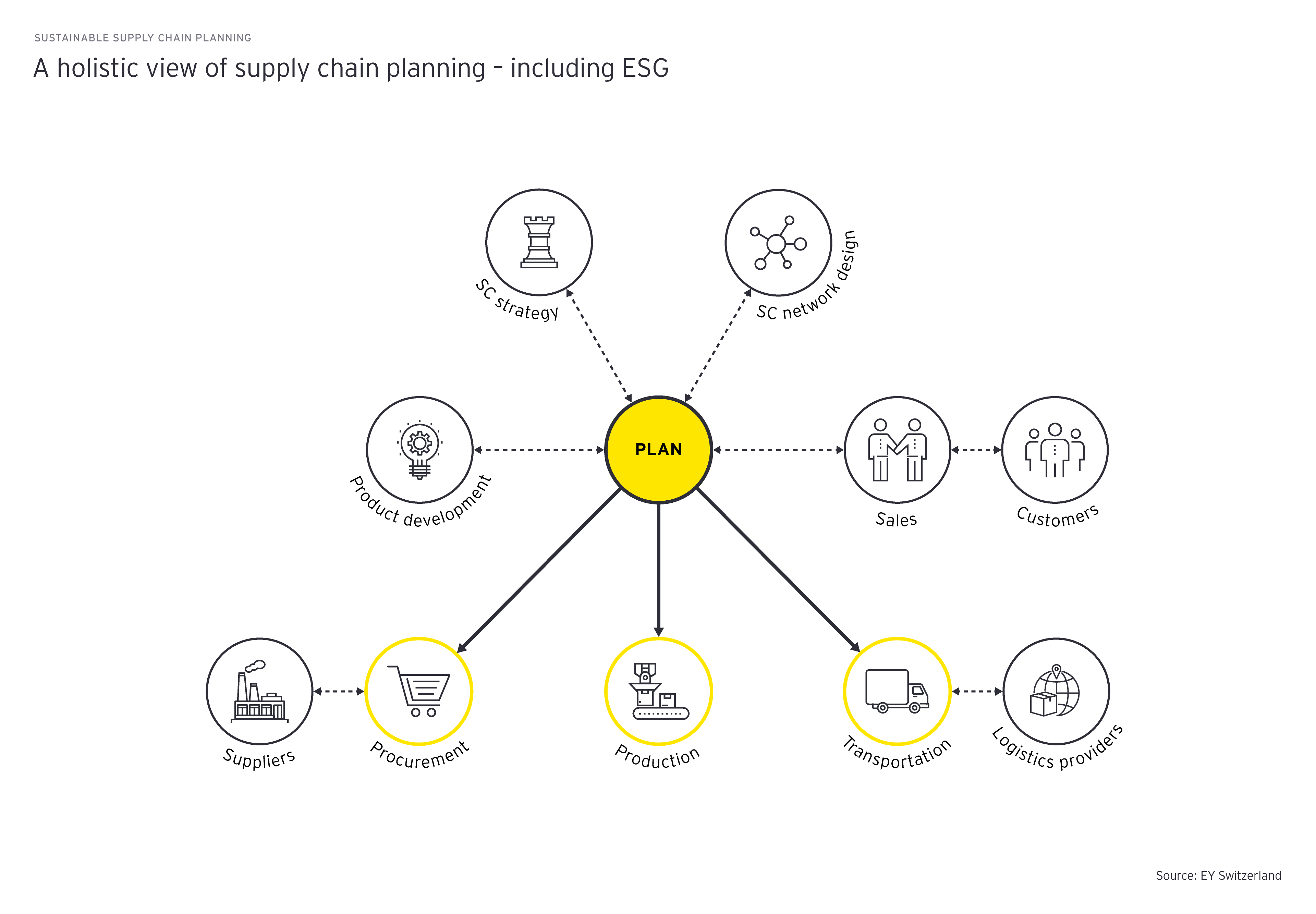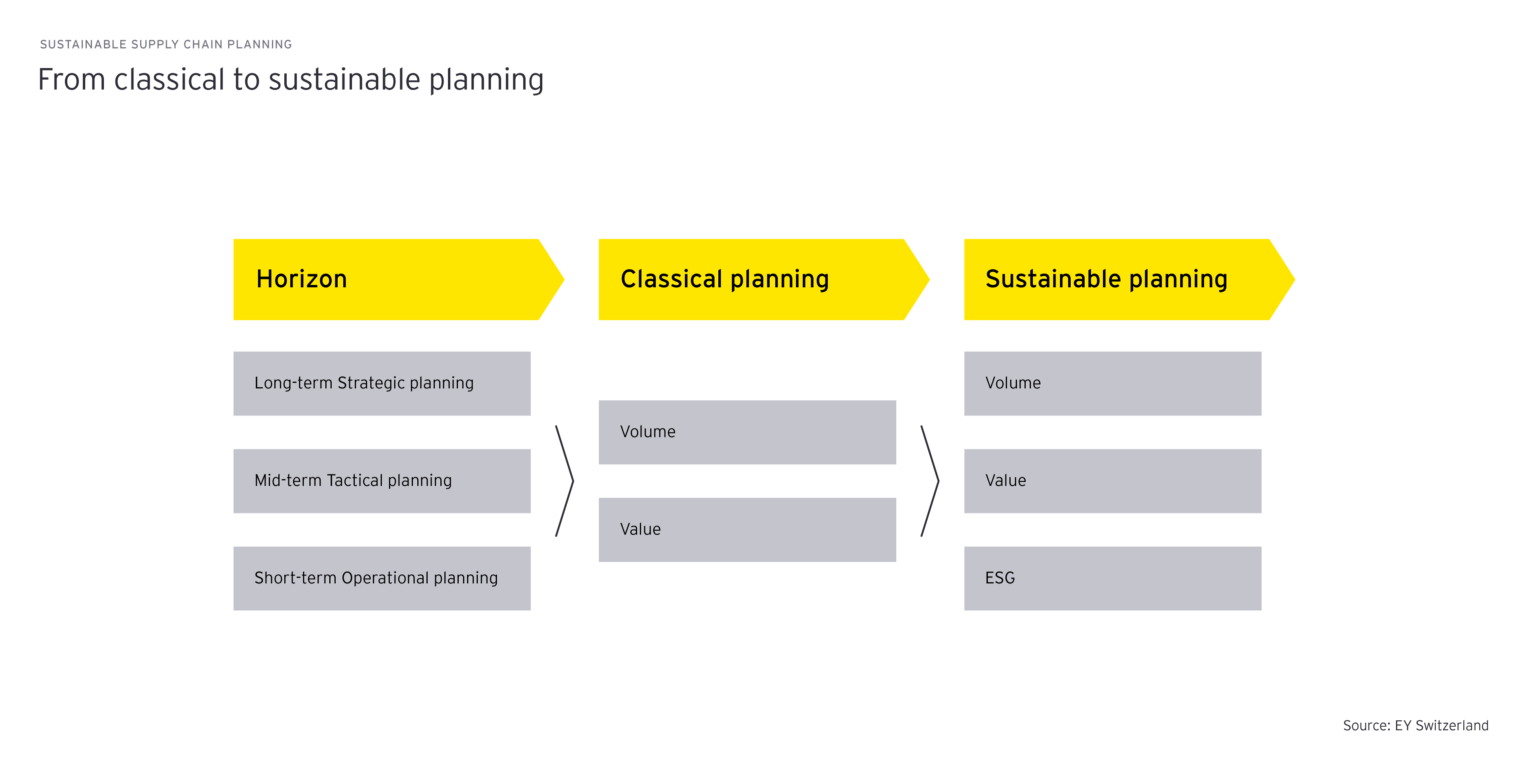EY refers to the global organization, and may refer to one or more, of the member firms of Ernst & Young Global Limited, each of which is a separate legal entity. Ernst & Young Global Limited, a UK company limited by guarantee, does not provide services to clients.

Enriching your company’s supply chain planning with the ESG dimension will help you steer the sustainability transformation.
In brief
- Regulatory trends and stakeholder expectations make sustainability a business imperative.
- Companies wishing to follow through on their sustainability ambitions should integrate ESG into supply chain planning.
- A solid framework and technology-enabled solutions can help organizations achieve sustainable planning with a positive impact along the end-to-end value chain.
Companies are under increasing pressure from rapidly evolving laws and regulations as well as changing expectations from customers, employees, investors and wider society. Against this background, sustainability action has become a business imperative.
Although many companies have made great strides in embedding sustainability in their strategy, setting ambitious targets and disclosing progress, value chains often still fall short in delivering real impact. Even when each node and function of the value chain understands the corporate sustainability strategy and their role in achieving its goals, how can the impact of daily decisions be assessed and considered? The reporting-dominated, backward-looking view of sustainability performance, coupled with an inability to project future environmental and social impacts, are currently causing a mismatch between intention and action.
We believe a radical new approach is needed to deliver on commitments at the speed and scale required by the urgency of environmental and social issues the world is facing. Given that on average, 80% of a company’s carbon footprint are Scope 3 emissions – i.e., those not produced directly by the company itself – the value chain is a good place to start.

Sustainable supply chain planning will redefine progress on sustainability action. A sustainable approach to planning focuses on visibility over all physical and information flows at every stage of the value chain. Since supply chain planning is steering operations (procurement, production and logistics) and influencing other functions (supply chain strategy and network design, sales, product lifecycle management), adding the ESG dimension will enable planning to act as a catalyzer of the transition. This will ultimately contribute to making your company’s value chain more sustainable, resilient and future proof.
As with any other strategy and approach, alignment and business integration will be of utmost importance to determine later tangible and achievable targets. Companies must find out what is desired and feasible in terms of environmental and social impacts.
To make this happen and develop a target operating model and framework for sustainable supply chain planning, management and planners need to be involved from the start. ESG key performance indicators (KPIs) will need to be defined within this framework at the corporate level to enable reporting on sustainability within and outside the organization.
After the corporate framework for sustainability has been set, supply chain planners will need to derive relevant ESG KPIs (e.g. at product and location level) to be incorporated into their forecasts and plans. This means considering ESG aspects at the strategic, tactical and operational levels to prioritize, address and understand the topics and decisions that have the most impact for companies environmentally, socially and economically.

The shift to sustainable planning sees the ESG dimension added alongside the traditional dimensions of volume and value. Sustainability targets become an additional lens to drive day-to-day decisions, which calls for a careful balancing of (new) trade-offs. This will ultimately lead to better forecasts balancing costs, service levels and sustainability impacts.
Supply chain planners have a broad area of direct and indirect influence with numerous action levers available to make real-time decisions in favor of sustainability. These action levers generally fall into two categories:
Technology as an enabler of change
Supply chain planners today have out-of-the-box technology and software at hand helping them with their decision-making and managing complex supply chains. However, to bring in the ESG dimension into the technology landscape and the planning systems, it is important to first establish where it applies in the supply chain.
Understanding how environmental and social impacts are associated with the company’s supply chain – and what data will be needed to track, control and steer the sustainability transformation – is very individual and requires a strategic approach. To achieve valuable insights and support for decision-making on sustainability through advanced analytics, the ESG data and metrics will need to feed into all layers of enterprise systems.
A variety of solutions in the market are available to help planners fully develop and leverage on sustainability capabilities by investigating the environmental and social impacts of the supply chain. Supported by the right data and technology, users get insights that enable them to predict, prepare and mitigate effects more efficiently.
Four steps to sustainable planning
Although every supply chain transformation journey will be different, there are some key steps that most organizations can follow to move from intention to action:
- The first step is to clarify which data are both needed from a sustainability steering point of view and should be translated into planning-relevant key figures (i.e., related to product flow).
- The second step is to integrate this ESG data and combine it with planning key figures, to provide visibility over future impacts and start educating planners with these new insights.
- The third crucial step – and certainly the most difficult – is to move from insights to action, by embedding the ESG dimension into planning decisions. This requires an upgrade of the planners’ job descriptions as well as an enhanced collaboration with all functions both internally and externally.
- To go beyond, the fourth step is to enrich optimization algorithms and cognitive automation solutions with ESG factors to create optimized plans at scale.
Acknowledgement
This article was originally published on the pages of EY Switzerland. We kindly thank the team for their valuable contribution to this article.
Newsletters EY Belgium
Subscribe to one of our newsletters and stay up to date of our latest news, insights, events or more.
Summary
No matter your maturity level, and whether you are seeking to comply with regulations or become a sustainability leader, sustainable supply chain planning will enhance your ability to deliver on your ambitions and strengthen your brand. We believe the right approach will help you balance profitability, customer service and sustainability in an integrated way. This is key to getting the green line and the bottom-line to work in harmony and for the benefit of all stakeholders.
Related article
How to use smart technology to support a resilient supply chain
The latest technology allows companies to anticipate unexpected circumstances and develop a resilient supply chain.
From planner to value chain strategist unleashing the power of supply chain transformation
When supported by the right technology, disruption leads to valuable transformation.




